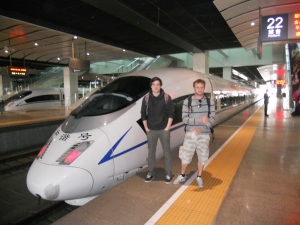Back in the beginning of May, we had a week off from our program at Tsinghua. Many of the other students from my program traveled outside of China to Vietnam, but because of visa issues and having to remain in the country, I traveled with two Spanish friends to Eastern China. Our trip started with a high speed train from Beijing to Tsingtao. Our train left from Beijing South Railway Station (Chinese: 北京南站; pinyin: Běijīng Nán Zhàn) which is great piece of new architecture that opened in August of 2008. The trip normally would be about 10-12 hours, but because we spent a little extra money for the high speed train, it only took five hours to get there. Qingdao (proper Chinese spelling) or Tsingtao (western spelling) is located the Shandong province and is a major seaport, naval base, and industrial center. Among students, this city is well known for being the home of one of the largest breweries in China. It was once a German colony back in the late 19th and early 20th century and when you arrive you can see all of the European influences in the architecture and city design. There are traditional chinese buildings within the city in addition to a large business district with modern skyscrapers. So all together, Tsingtao has a unique urban atmposhere with all these different styles and cultures combined into one city. One interesting thing to note about China, is that there are no small cities in China, at least from what I have seen. I’m sure there are in isolated rural parts of the country, but I was expecting Tsingtao to be a nice small city by the ocean, when in fact it was a booming city with a population of almost eight million people.
We arrived at lunch time, and after checking into our hostel we decided to explore the beach. I thought that the air quality would be better in a city by the ocean compared to Beijing because of the wind and air movement, but smog can be just as bad in Tsingtao as it can in Beijing. The smog was not too bad on our first day, but still put a bit of a damper on our beach exploration. Despite the poor visibility, you could still see some very beautiful sites, but this was also the last day of a Chinese holiday, so the tourists were out in full force. We had more “local celebrity” moments where people wanted there picture taken with westerners. In the mid-afternoon, we came across newly-weds that were taking their pictures. At first you think, oh this is a really nice place to have your wedding pictures taken, until we made it to the other side of the hill to see that there were 10-15 couples getting wedding pictures taken. We walked for down the beach from after lunch until late in the evening, and after checking a map afterwards, realized that we barely even made a dent in the area of the city. Knowing that we were only there for one more day, we decided to visit the main attraction of Tsingtao, Lao Shan National Park.









